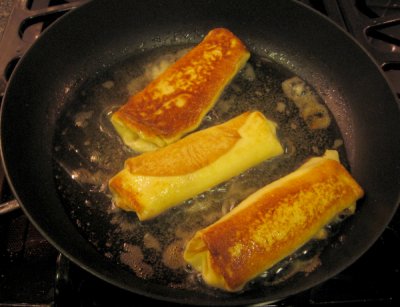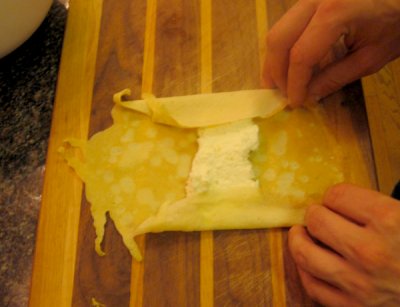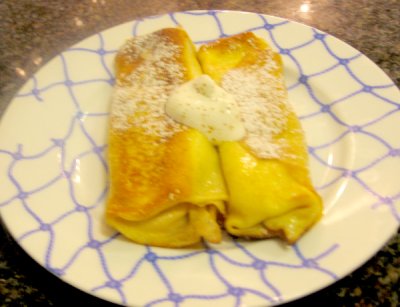- Russianfoods.com

It was lunchtime in my Jewish day camp and everyone was yelling. At my table, Harris Goodman dug his fists into the apple sauce, and David Silver investigated what could be done with the right combination of sour cream, apple sauce and a drinking straw; he was quickly warming to the idea of edible snot rockets. Two soggy logs the color of a manila folder sat on my plate. I poked at one with my fork and lukewarm cottage cheese gurgled out like spittle from a burping baby. I looked over at Mikey Edelstein, who seemed to be enjoying his. What are these? I asked him. Blintzes, he said, my Bubby makes them.
The origins of the Blintz are unclear, but it is certain that the half-frozen disaster I encountered that day, were not (as I'd imagined at the time) the thing that Mikey Edelstien's Bubby served him. The origin of the Blintz, both linguistically and gastronomically, seems to be the Russian Blini. Named from the Slavic word mlin, meaning "to mill", the thin buckwheat pancake was used in Pre-Christian Russia as a religious symbol for the sun. Today, blini are still served with sour cream and caviar, or smoked salmon. Blini evolved into the Blinchiki, a similar crepe filled with meat or cheese, which became the Yiddish Blins or Blintz, a staple in the Jewish cookbook going back to the first Eastern-European shtetles. As with most folk foods, there are endless varieties of blintzes. Many homes use the blintz crepe as a way to extend the shelf-life of leftover food, filling it with cooked meats or pickled vegetables. Most people, however, associate the blintz with a soft, sweet cheese filling. At their best, cheese blintzes are crispy on the outside, and dusted generously with confectioners' sugar. The inside is gooey, and the taste, though not the consistency, is almost like a warm cheesecake wrapped in a paper-thin souffle. Blintzes are usually served with sour cream or applesauce, and the end result is somewhere between a pierogi, a funnel cake, and a French crepe.
Blintzes
Mario Batali is always reaching for a bowl of perfectly golden, homemade Italian breadcrumbs and suggests that they're "something you might have on the windowsill, or in a mason jar in the pantry" – but when was the last time you found Molto Mario-quality breadcrumbs in your pantry? In the case of blintzes, the important thing is not to stress out about finding the right ingredients; this is food that's meant to be around the house already - really. Feel free to make substitutions and play around with your recipe. Blintzes are forgiving, and can be made in an infinite number of ways. Water can stand in place of milk, and some recipes I've seen call for fewer eggs and more flour, and yield a more cake-like pastry. When it comes to filling, it's a question of availability and your own taste.
Filling
15 oz. (two packages) farmer cheese
4 oz. (about half a package) cream cheese
2 egg yolks
1 tbsp sugar
1 tbsp lemon zest
1/4 tsp vanilla extract.
Crepes
1 cup milk
4 eggs (yolk and white)
1 egg white (from filling)
2 tbsp melted butter
1 cup flour
1 tsp white sugar
1/4 tsp cinnamon
dash of salt
butter (for frying)
Cream the farmer cheese and cream cheese together. Separate the 2 yolks, and set aside 1 of the whites to be used in the crepe. Add the sugar, vanilla and zest, and mix together until smooth. It should be the consistency of whipped cream cheese, though because of the farmers cheese it will be considerably lumpier. Cover with plastic wrap and set aside.
For the crepes, whisk together the milk, 4 eggs, and salt, and set aside. In a separate bowl, mix together the remaining dry ingredients until they seem homogenized, and the flour is no longer lumpy. If you are using a food processor or standing mixer, mix the dry and wet ingredients for about 1 minute on HIGH. If you are working by hand, slowly add the contents of the dry bowl to the milk/egg/salt mix and beat with a whisk. The resulting batter should be smooth and thin, with a consistency between whole milk and a smoothie. If you notice any lumps, run the batter through a mesh strainer. Chill for 30 minutes in the refrigerator.
Set your skillet on a medium-high heat and place a small amount of butter (about a tablespoon) in the pan. When the pan is hot enough for the butter to bubble but not burn, place around a tablespoon of batter in the pan. Depending on the size of your skillet, this amount may vary; just make sure to cover the bottom of the pan with a very thin layer of batter by tilting the pan to spread the batter, as you would with melting butter. Cook the crepe until brown on its underside (about a minute) then remove from heat and place on a plate, brown side up. Repeat this process, stacking the crepes one on top of the other until the batter is finished. Again depending on the size of the pan, this recipe should yield 12 big to 16 small crepes.
To fill the crepes, place flat, brown side up and place a generous tablespoon of the filling in the center. Spread the filling across the full area of the circle, fold in opposite sides, and roll across, like a burrito.

To cook, place cooking oil and a small amount of butter in your skillet on a very high heat, and cook the rolled blintzes until browned and crispy on all sides. Dust with confectioner's sugar. Serve with sour cream, applesauce or jam.


No comments:
Post a Comment